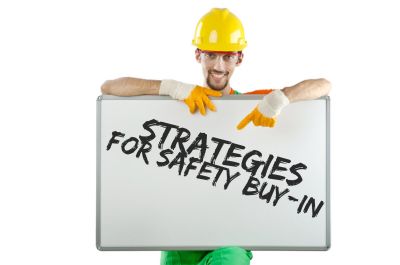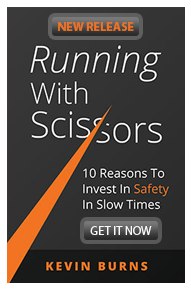When you have achieved successful buy-in, your people can help turn a company’s mundane safety program into a movement built around a set of values, rather than rules.
 Pick any night of the week and you’re likely to stumble across a repeat broadcast of the TV shows Shark Tank (USA) or Dragon’s Den (Canada, UK, Australia, etc). Entrepreneurs pitch their business ideas to secure investment finance from a panel of venture capitalists. If the pitch is a good one, there’s a good chance of getting buy-in from one or more of the Dragons or Sharks. If the pitch misses the mark, they go home empty-handed.
Pick any night of the week and you’re likely to stumble across a repeat broadcast of the TV shows Shark Tank (USA) or Dragon’s Den (Canada, UK, Australia, etc). Entrepreneurs pitch their business ideas to secure investment finance from a panel of venture capitalists. If the pitch is a good one, there’s a good chance of getting buy-in from one or more of the Dragons or Sharks. If the pitch misses the mark, they go home empty-handed.
Take this idea and apply it to safety. Instead of looking at a safety meeting as a place to pitch stats, figures, reports and procedures, view your safety meeting attendees as potential investors. If your pitch misses, your people won’t invest themselves in safety. Your presentation won’t yield the buy-in you’re looking for. But if you pitch successfully, you’ve offered plenty of benefits and helped eliminate the mental barriers to improve safety culture. If you want to build a solid safety culture, you’re going to need employee buy-in.
Here are three strategies that can get you started in improving buy-in to the safety program:
1Assess your pitch and your messaging. Study the last safety meeting presentation you made. Did you prepare compelling arguments for investing in safety? Was anyone convinced to invest their time, energy, and effort in your goals for improving safety? Ask yourself whether reading a bunch of stats and data created a groundswell of safety investors. Did your pitch convince your best people to buy into the latest initiative? Investors invest in the product, but more importantly, they invest most of all in the individual. Investors love people with a great product, a solid plan, and passion for what they're doing. Your passion and convictions for safety must be evident. You will not get employee buy-in without your own conviction readily evident. Your people are your investors and you want them to invest themselves.
2Identify the immediate benefit of buying-in. People will buy into something that creates a win for them. So, remove the mental barriers to investing in safety. Stop pointing out what workers might lose. Negative reinforcement as a motivator has no lasting value. And, it requires constant repetition, each time ramping up the degree of shock in order to make an impression. But, the best you can hope for from this negative reinforcement is simple rules compliance. But that’s not true buy-in to safety. Instead, focus on what they’ll gain. Put a positive spin on safety to show why it’s good for them. Focus on how safety ensures a steady cash-flow (paycheck), sets them up for retirement comfortably and helps them build a positive legacy. Safety does that and more, today and everyday.
3Remove the excuses for not choosing safety. When excuses get in the way, they become barriers to good safety. So address the excuses. Hash things out in open discussion with your team and encourage dialogue. Facilitate safety meetings that allow attendees to talk about the excuses they make for not embracing safety. Have honest discussions about how they can help improve safety. When meetings are led with honest, frank, and open discussion, attendees respond positively. People want to feel empowered. Many may be surprised at their own willingness to speak up. Safety buy-in happens when you deal effectively with safety perceptions, beliefs and attitudes that undermine safety. Help others to come to their own realizations that safety is not an enforcement program of rules and procedures. It is a lifestyle choice meant to help them stay healthy, help their performance and build value in their contributions.
 People don’t buy things logically. They buy things emotionally. Once they have made the decision to buy in, people then use logic to justify their purchase. They’ll use statistics, facts, and figures to validate the decision they made.
People don’t buy things logically. They buy things emotionally. Once they have made the decision to buy in, people then use logic to justify their purchase. They’ll use statistics, facts, and figures to validate the decision they made.
You don’t buy a new truck because of the stats and figures in a brochure. You buy a new truck because of how it looks, how it performs and how it makes you feel. Throughout the test drive, your brain is in overdrive, processing information in combination with sight, smell, sound, and touch. When you feel good driving it, that’s the emotion kicking in and that’s what sells you on the truck. Once you’ve made your emotion-based purchase, you’ll justify it with logical facts and figures.
When you have achieved successful buy-in, your people can help turn a company’s mundane safety program into a movement built around a set of values, rather than rules.
Kevin Burns is a management consultant, international thought-leader in workplace safety, and a speaker based in Calgary, Alberta, Canada. Kevin has authored ten books on human performance and safety, including his most recent release, PeopleWork - The Human Touch in Workplace Safety. Buy his new book on Amazon. Then, consider bringing Kevin's consulting expertise to your company or have him speak at a future safety event.
©2017 ZeroSpeak Corporation and Kevin Burns.
No part of this post may be reproduced without the expressed consent of the author.


